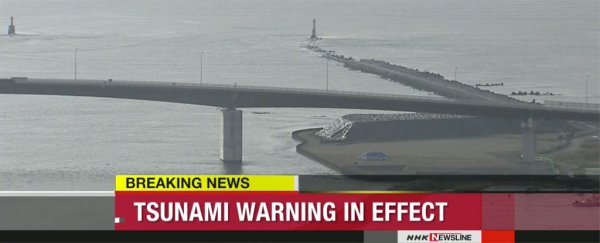Japan is on high alert after a 7.4 magnitude earthquake struck the northeast of the country at about 6am local time.
The quake, estimated to have occurred at a depth of around 30 kilometres (18.6 miles), was located off the east coast of Fukushima Prefecture, which bore the brunt of the 2011 Tōhoku earthquake and tsunami that triggered the Fukushima nuclear reactor disaster.
About an hour after the quake, waves of up to 1.4 metres (4.6 feet) were recorded on the east coast, local broadcaster NHK World reported, but authorities have warned that waves could get even higher – potentially up to 3 metres (9.8 feet) – and could also trigger landslides.
Though not as strong as the devastating 2011 quake that had a magnitude of 9.1, today's quake was still felt around the nation, with tremors shaking buildings as far away as Tokyo, some 240 kilometres (150 miles) southwest of the epicentre.
The Japan Meteorological Agency (JMA) originally issued tsunami warnings (but within the last hour, at about 9:50am local time, downgraded this to tsunami advisories) for both Fukushima Prefecture and Miygai Prefecture, directly to Fukushima's north.
A tsunami warning means damage due to waves is expected in these areas, with people asked to evacuate immediately from coastal regions and riverside areas to higher grounds or evacuation buildings.
In this situation, tsunami waves can be expected to hit repeatedly, the agency says, and advises citizens to avoid leaving safe ground until the warning has been lifted.
While the danger isn't over, the two prefectures have now been downgraded to a tsunami advisory warning, which carries less risk, but states that a marine threat is present, advising that people to get out of the water and leave coastal regions immediately.
So far, only small waves have been recorded, but there are fears that giant waves could still hit the coastline, as they did after the 2011 quake, which killed almost 16,000 people.
"It began with very, very small waves exactly as now," NHK journalist Judit Kwaguchi told ABC News. "But it increased up to 8 metres [26.2 feet] and even 15 metres [49.2 feet]."
Replay on NHK just now showed shaking from todays quake in Japan. pic.twitter.com/RFfxzcRS8X
— Jim Dalrymple II (@Dalrymple) November 21, 2016
At time of writing, no fatalities had been reported from today's quake or tsunami.
Representatives for the Tokyo Electric Power Company (TEPCO) that runs the Fukushima Daiichi power plant said that the cooling system in the No. 2 reactor had stopped working for a brief period, possibly due to the vibrations of the quake, but had been reactivated. No irregularities have so far been detected.
While the tsunami risk has been downgraded since the earthquake first struck, experts have warned that a second quake or aftershock could still trigger dangerous waves, so will be monitoring the situation closely.
For live updates on the situation, see The Guardian's live blog here.
Here's hoping the worst has already passed – we're thinking of you, Japan.
 USGS
USGS
